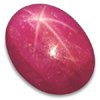
March Editorial
Microwaves make rubies redder

March Editorial
Microwaves make rubies redder
|
|
Properly speaking, there are only four types of precious stone. These are diamonds, emeralds, sapphires and rubies. The ruby is the precious stone which we discuss in this article. Technically speaking, rubies have a structural composition of Al2O3:Cr in which a small amount of Al3+ is replaced by Cr3+ ions (a variety of mineral corundum). Corundum is an aluminium oxide with a hexagonal crystal structure. Corundum comes mainly from metamorphic and volcanic rocks. The other precious stone which is also a corundum is sapphire. Sapphires exist in almost any colour although the most common variety is blue. However, sapphires are never red, and rubies are always red, though that red might go from baby-pink to dark blood-red. Rubies have a long history. They were known and treasured by the Egyptians. There are also biblical references to rubies, referring to them as the most precious of stones. ‘Who can find a virtuous woman, for her value is higher than rubies?’ asks Proverbs 31.10. (Actually though, it is likely that the stones called 'rubies' in the Old Testament and other ancient texts may in fact have been garnets or spinels. These stones were often confused. Even in the British Crown Jewels there is a 'ruby' which is actually a spinel!) With true rubies, red rubies are found mainly in Burma, Thailand and Sri Lanka, with 'pinkish rubies' coming most commonly from Vietnam, Madagascar and southern Tanzania. The brightest and most valuable type of red is 'blood-red' or 'pigeons' blood'. These rubies fetch a large premium over other rubies of similar quality. In fact, the distinctive 'pigeons' blood' rubies from Mogok (Burma) are the most expensive rubies on earth. One such ruby, the Sunrise Ruby, is the world's most expensive coloured gemstone, and the most expensive gemstone other than a few famous diamonds. In May 2015, at a Sotheby’s auction in Geneva, the Sunrise Ruby was sold for a record 30 million US dollars to an anonymous buyer. While the price of a ruby is primarily determined by its colour, after colour comes clarity. As with diamonds, a clear stone is more expensive. The reason why good-quality rubies are so expensive is because they are also rare. Most natural rubies have non-uniform colour saturation, sometimes with visible blue patches. Over the years, a number of techniques have been developed to enhance the red in a ruby’s colour and also to hide impurities. These methods include heat treatment in different chemical environments, high-energy particle or electron beam irradiation, surface coating, and laser treatment. Heat treatment is the oldest and most common way of improving colour saturation, clarity, and thus the market value of the gemstones. Some researchers have reported that it is possible to remove a ruby’s dark core and blue patches by the use of heat treatment in a reducing or oxidizing atmosphere. Now scientists are developing a new way to improve the colour, clarity and lustre of rubies. They put them in a microwave. Microwave heating has already been used on other materials such as ceramics, metals and composites. It has been shown to have several benefits over conventional heating. The heating is less costly and faster and more uniform, and it yields finer microstructures in a more eco-friendly process. To test the microwave treatment, scientists collected natural rubies (ruby gemstones) from the Sinapali (Nuapada district) of Odisha. The rubies varied in size between 5 and 11 mm. Before heat treatment, the raw samples were first cleaned with isopropanol to remove dirt and grease. The gemstones were then placed in a 3-kW industrial MW furnace with SiC susceptors and microwave heated at 1500 degrees Celsius (unfortunately your standard home appliance just won't do). This MW heat treatment at 1500 C (±30) produced visible changes in the colour and structure of the rubies. Specifically, the colour of the gemstones changed from reddish black to light pink and the clarity and lustre were improved. The team then used various techniques to investigate and compare the microwaved ruby samples with untreated specimens. These techniques included X-ray diffraction, ultraviolet-visible spectroscopy, fluorescence spectrophotometry, Raman spectroscopy, and X-ray photoelectron spectroscopy. It was found that the visible changes in the gemstones' colour were reflected in changes to their structure.The researchers believe this change in the stones' surface colour and the increase in clarity may have been caused by the microwaves altering their chromium, iron and titanium elements. Furthermore, among other changes, there were fewer defects, irregularities and impurities in the stones; probably because of changes in their atomic layout and crystal structure. The researchers showed that the use of microwave heating has many advantages for the gemstone industry. It is quicker and more uniform than conventional heating, which in turn can aid rapid product development. Because treatments such as standard heat or microwave may aid in improving the colour and luster of lower-grade rubies, these can now be used by jewellers. This tempering has caused the overall price of rubies to go down. Treated low-grade rubies can now be made to closely resemble high-grade untreated stones and it is hard to prove that a stone has not been treated. So, for example, a pure high-grade ruby without any needle-like rutile inclusions is now regarded with suspicion because the absence of these inclusions may indicate that the stone has spent time in the microwave. Journal Reference: |
| _______________________________ | ||||
| Home | | | Shopping | | | Database |
© Biscuit Software 2004-2015
All rights reserved